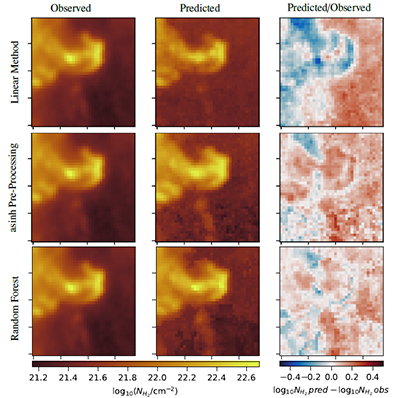- Details
- Published on 23 December 2020
Vol. 645
6. Interstellar and circumstellar matter
C18O, 13CO, and 12CO abundances and excitation temperatures in the Orion B molecular cloud
Quantitative inference of the H2 column densities from 3mm molecular emission: Case study towards Orion B
Tracers of the ionization fraction in dense and translucent gas. I. Automated exploitation of massive astrochemical model grids

The increase in bandwidth and sensitivity afforded by the latest generation of milliliter wave receivers has made it possible to map large areas of the sky using multiple GHz bandwidths that contain dozens of molecular lines. Extracting information from these complex data sets represents a challenge to observers, and it has motivated the development of new semi-automatic analysis techniques. In this volume, the ORION-B team presents three papers that illustrate some of the new techniques developed to characterize the Orion B molecular cloud using observations carried out with the IRAM 30m telescope.
In one of the contributions, Pierre Gratier and collaborators present the use of supervised machine learning methods (Random Forests) to train a predictor of the H$_2$ column density. These authors used a limited set of molecular lines in the 3mm-wavelength band as input and Herschel-based dust-derived column densities as the “ground truth” output. With their new technique, Gratier et al. estimate that they can predict the H$_2$ column density within a typical factor of 1.2 compared to the Herschel-based column density estimates.
In a separate contribution, Antoine Roueff and collaborators use the Cramer Rao bound technique to analyze and estimate the precision of physical parameters derived from the analysis of low-J transitions for the most common CO isotopologues. These authors propose a maximum likelihood estimator to infer the physical conditions from the 1-0 and 2-1 transitions of CO isotopologues, and from its use, they find local deviations of the mean fractional abundances across the cloud that likely result from the competition between selective photodissociation, chemical fractionation, and the depletion on grain surfaces.
In a third contribution, Emeric Bron and collaborators searched for the best observables of the gas ionization fraction using a grid of astrochemical models, and they estimated their predictive power by training a Random Forest model. From this work, the authors identify several observables that are better and more widely applicable than the commonly-used DCO$^+$/HCO$^+$ ratio. They also provide analytical fits to estimate the ionization fraction from the best observables and to derive the associated uncertainties.


